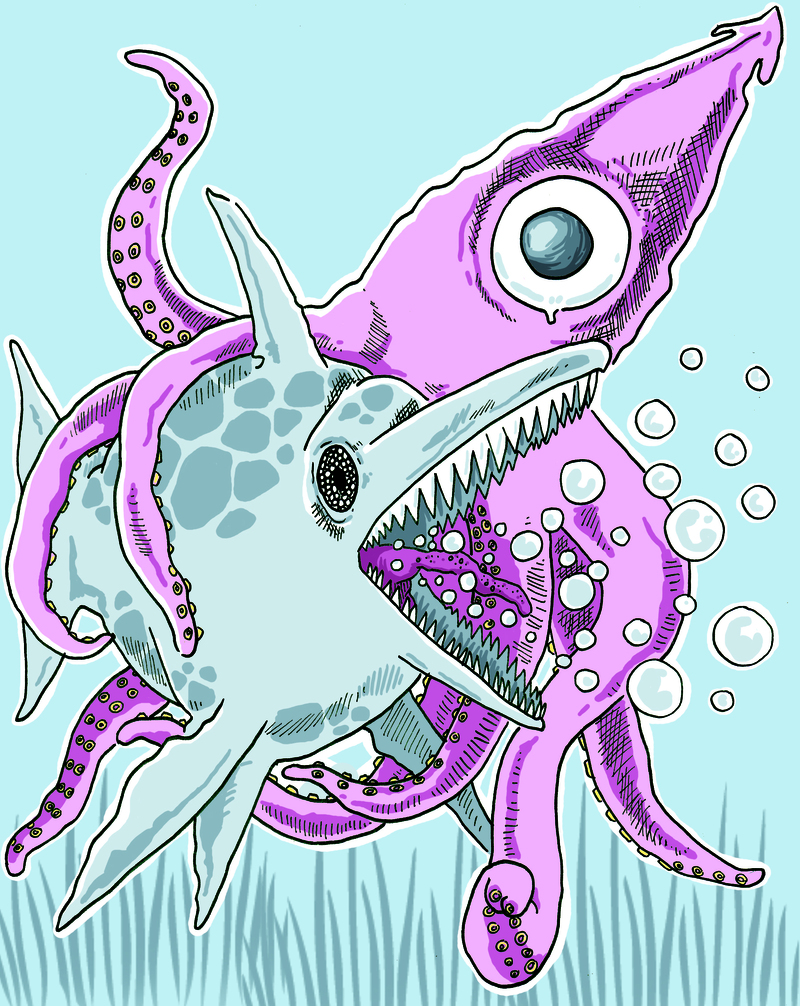This week in science fiction: the kraken — a giant squid mythologized by centuries of sailors — is being held responsible for a mass grave of neatly arranged 220-million-year-old ichthyosaur fossils, excavated some 83 years ago in the Nevadan desert. The bus-sized ichthyosaur lived throughout the Mesozoic-era; it was an air-breathing marine reptile, dolphin-like in resemblance.
Over the years, the collection of suspiciously arranged vertebrae has received attention from the paleontology community; many have puzzled over how they came to be this way.
One explanation previously thought plausible was that these assemblages of ichthyosaur bones might be the result of some form of “beaching” incident akin to what is sometimes exhibited today in whales. Perhaps this group of ichthyosaurs was unwittingly thrust ashore by a tsunami.
Another explanation is that the nine ichthyosaurs were poisoned by a toxic algae bloom and died instantaneously. Either hypothesis may account for why the nine ichthyosaur skeletons were found in such close proximity; unfortunately, neither satisfy how these bones in particular came to be laid about in such a suspiciously tidy presentation.
The apparent symmetry with which they are aligned next to each other caused paleontologist Mark McMenamin to recently entertain the possibility that they were captured, killed and ordered this way by a massive, intelligent prehistoric squid — the kraken.
His extraordinary hypothesis is encompassed within a few novel observations. First, claims McMenamin, the way in which the individual backbones were found lying parallel next to each other is itself unusual. However, according to McMenamin, several of the vertebrae seem to be out of place or even rearranged — rearranged so as to correspond to the sucker arrangement of a hitherto undiscovered cephalopod of monstrous proportions: a self-portrait of the kraken itself.
McMenamin observes “the vertebral disc ‘pavement’ seen at the state park may represent the earliest known self-portrait,” reports National Geographic. In summation, McMenamin believes the kraken hunted the ichthyosaurs and then went to the trouble of dragging them back to a lair filled with the remains of previous kills. And after cleaning a kill to the bone, the kraken would artfully render the vertebrae in shapes that, McMenamin believes, reflect the creature’s first-person perspective of his own tentacles.
Upon submitting this hypothesis to a panel of his peers at a recent American Geoscience Institute seminar, mixed reviews have ensued — both in the world of science and the media.
The standard strike against McMenamin’s hypothesis might be that it is highly implausible conjecture, and postulating “a folklorish genius monster-squid did it”— again, one that is not documented in the fossil record — only serves to overcomplicate the debate. Even if we ignore the tiny fact of the alleged perpetrators nonexistence, the appearance of a design does not out of necessity entail a designer. Evolution hardwired our brains to seek out patterns in the natural world; the natural world forced pattern-seeking behaviour into us because it proved to benefit our odds of survival.
And though this software often leads us to great discoveries, it can also lead us to see patterns in the face of nature that aren’t really there.
We never have to subscribe to any proposition on insufficient evidence, no matter how queer or commonplace the claim. The late great astrophysicist Carl Sagan would want us to abide by what he once said: “Extraordinary claims require extraordinary evidence.”
But this is not to throw the kraken out with the bathwater. There have been huge cephalopod fossils uncovered from the same period ichthyosaurs marauded the murky depths, just not “kraken huge.” Not yet, anyway.
To round out this discussion, we need only look to Charles Darwin. He once came across the Madagascar orchid in his voyages. The orchid, with its long spaghetti-like nectary, persuaded him to infer the existence of a kind of moth that would have a complementarily long proboscis, with which it and only it could mine the nectar from the base of the Madagascar orchid. Low and behold, the very moth Darwin hypothesized, the hawk moth, was discovered years later doing just that.
At very least, the analogy of Darwin’s hawk moth hypothesis-turned-proven-theory is one that should temper our immediate dismissal of McMenamin’s kraken.


Great article. None of the usual and clichéd pokes at the out-of-step scientist. There should be more articles like this – that acknowledge doubt around a strange theory without ridiculing the theorist. Better yet, it reminds us that no proof is not disproof and that many over-the-top theories turn out to be true.